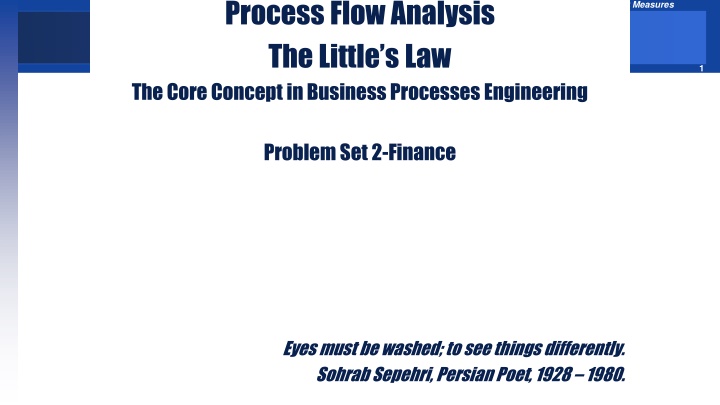
Key Concepts in Business Process Engineering
Explore the core concept of Little's Law in business processes, with a focus on process flow analysis and measures like current assets, balance sheets, and inventory management. Learn how to calculate average flow times through accounts receivable and payable to optimize cash flow and business operations.
Download Presentation

Please find below an Image/Link to download the presentation.
The content on the website is provided AS IS for your information and personal use only. It may not be sold, licensed, or shared on other websites without obtaining consent from the author. If you encounter any issues during the download, it is possible that the publisher has removed the file from their server.
You are allowed to download the files provided on this website for personal or commercial use, subject to the condition that they are used lawfully. All files are the property of their respective owners.
The content on the website is provided AS IS for your information and personal use only. It may not be sold, licensed, or shared on other websites without obtaining consent from the author.
E N D
Presentation Transcript
Process Flow Analysis The Little s Law The Core Concept in Business Processes Engineering 3. Process Flow Measures K1 . The Coffee Shop 1 Problem Set 2-Finance Eyes must be washed; to see things differently. Sohrab Sepehri, Persian Poet, 1928 1980.
3. Process Flow Measures M5. Financial Accounting 2 Current Assets Cash Short-Term Investments At Cost Receivables, Less Allowances Of $0.7 Mil Inventories Other Current Assets Total Current Assets Property, Plant And Equipment (At Cost) Land Buildings Machinery And Equipment Construction In Progress Subtotal Less Accumulated Depreciation Net Property, Plant And Equipment Investments Prepaid Expenses And Other Deferred Other Assets Total Assets Current Liabilities (Selected) Payables Net Sales 250.00 2.1 3 Costs And Expenses Cost Of Goods Sold Selling, General And Administrative Expenses Interest Expense Depreciation Other (Income) Expenses Total Costs And Expenses 27.9 50.6 4.1 87.7 175.80 47.20 4.00 5.60 2.10 234.70 2.1 15.3 50.1 6.7 74.2 25 49.2 4.1 1.9 Income Before Income Taxes Provision For Income Taxes @0.46 Net Income 15.30 7.04 8.26 Retained Earnings, Beginning Of Year Less Cash Dividends Declared Retained Earnings At End Of Year 31.00 2.10 37.16 4 147 Net Income Per Common Share Dividend Per Common Share 0.83 0.21 11.9
3. Process Flow Measures M5. MBPF Inc.: Inventory and Cost of Goods 3 Inventory Raw Materials (Roof) Fabrication WIP (Roof) Purchased Parts (Base) Assembly WIP Finished Goods Total 6.5 15.1 8.6 10.6 9.8 50.6 Cost Of Goods Sold Raw Materials Fabrication (L&OH) Purchased Parts Assembly(L&OH) Total 50.1 60.2 40.2 25.3 176
3. Process Flow Measures M5. MBPF Inc.: Balance Sheet 4 Compute average flow time through Accounts Receivable. A flow unit here is a dollar of Accounts Receivable Throughput RAR = $250 million/year (net sales from income statement) Average Inventory IAR = $27.9 million (from the balance sheet) TAR = IAR/RAR TAR = $27.9/$250 TAR = 0.112 years or 5.80 weeks After a sale is made, the firm must wait almost 6 weeks before sales dollars are collected! Decreasing this lag time between sale and collection can dramatically improve cash flow for the company to route to other needs!
3. Process Flow Measures M5. MBPF Inc.: Balance Sheet 5 Compute average flow time of Accounts Payable. Flow unit here is $1 of AP Average accounts payable (inventory in purchasing) is $11.9 million = IAP Throughput RAP= Purchased Raw Materials + Purchased Parts RAP= $50.1 million + $40.2 million = $90.3 Million TAP = IAP/RAP TAP = 11.9 / 90.3 TAP= 0.13 years or 6.9 weeks to pay a bill.
3. Process Flow Measures M5. MBPF Inc.: Inventory and Cost of Goods 6 Compute the average flow time in production operations: I = TR I = Total Inventory, R = Cost of Goods Sold T = $50.6MM (value of inventory) / $175.8 MM (Annual COGS) T = 0.288 years or 15 week It takes 15 weeks for a dollar invested in the factory to be billed to a customer.
3. Process Flow Measures M5. Analyzing Financial Flows: Cash-to-Cash Cycle 7 Cost-to-Cash Cycle: Measures time between the point that cost dollars are invested and sales dollars are received. Cost-to-Cash-Cycle:MBPF Inc. = + 15 weeks in production + 5.8 weeks in AR after the point of sale Cost-to-Cash-cycle = 20.8 weeks Cash-to-Cash Cycle: Similar, but nets out lag time in AP. MBPF Inc. pays for the cost dollar 6.9 weeks after a purchase (cost) is made. Cash-to-Cash-Cycle:MBPF Inc. = + 15 weeks in production + 5.8 weeks in AR after the point of sale - 6.9 weeks in AP after the point of purchase Cash-to-Cash-cycle = 14.1 weeks
3. Process Flow Measures M5. Analyzing Financial Flows: Improvement with Flow Analysis 8 Throughput (R) of each department: the cost of inputs + the cost of human and capital resources (labor, equipment, building, etc.) For MBPF, throughput in fabrication is: $50.1 million/year in raw materials + $60.2 million in labor and overhead R = $110.3 million/year total throughput. Flow Analysis is important in order to improve process performance. Conduct a detailed flow analysis of each step of the process. Identify the area within a process that can benefit the most from improvements
3. Process Flow Measures M5. Row Material and Resources 9 $60.2/yr $25.3/yr $50.1/yr Raw Materials (roofs) Fabrication (roofs) $40.2/yr Assembly Finished Goods Purchased Parts (bases) Inventory Raw Materials (Roof) Fabrication WIP (Roof) Purchased Parts (Base) Assembly WIP Finished Goods Total 6.5 15.1 8.6 10.6 9.8 50.6 Cost Of Goods Sold Raw Materials Fabrication (L&OH) Purchased Parts Assembly(L&OH) Total 50.1 60.2 40.2 25.3 175.8
3. Process Flow Measures M5. Throughput and Inventories at Different Processes 10 $60.2/yr $25.3/yr $110.3/yr $50.1/yr $6.5 $15.1 Raw Materials (roofs) Fabrication (roofs) $175.8/yr $175.8/yr $10.6 $9.8 $40.2/yr Assembly Finished Goods $8.6 $40.2/yr Purchased Parts (bases) Inventory Raw Materials (Roof) Fabrication WIP (Roof) Purchased Parts (Base) Assembly WIP Finished Goods Total 6.5 15.1 8.6 10.6 9.8 50.6 Cost Of Goods Sold Raw Materials Fabrication (L&OH) Purchased Parts Assembly(L&OH) Total 50.1 60.2 40.2 25.3 175.8
3. Process Flow Measures M5. Flow Times 11 Inventory Raw Materials (Roof) Fabrication WIP (Roof) Purchased Parts (Base) Assembly WIP Finished Goods Total 50.1 6.75 110.3 7.12 40.2 11.12 175.8 3.14 175.8 2.90 6.5 15.1 8.6 10.6 9.8 50.6 Cost Of Goods Sold Raw Materials Fabrication (L&OH) Purchased Parts Assembly(L&OH) Total 50.1 60.2 40.2 25.3 175.8 $60.2/yr $25.3/yr $110.3/yr $50.1/yr $6.5 $15.1 Raw Materials (roofs) Fabrication (roofs) $175.8/yr $175.8/yr $10.6 $9.8 $40.2/yr Assembly Finished Goods $8.6 $40.2/yr Purchased Parts (bases)
3. Process Flow Measures M5. Flow Rate vs. Flow Time 12 Flow rate R ($/week) 4.8 3.38 Accounts Receivable 2.12 Assembly Finished Goods Fabrication 0.96 Raw Materials 0.77 Purchased Parts 11.12 5.80 6.75 3.14 2.90 7.12 Flow Time T (weeks)
3. Process Flow Measures M5. Analyzing Financial Flows: Improvement with Flow Analysis 13 Working capital in each department includes the amount of inventory in it. Flow time here is the amount of time a cost dollar spends (on average) in that department. We can then ask, in which department does a reduction in flow time have the greatest impact on working capital? The larger the current flow time, the greater an impact in decreasing flow time will have on reducing working capital. In the MBPF example, we learn that a 1 week reduction in AR would free up approximately $5MM to the firm!
3. Process Flow Measures M5. Inventory Turns (Turnover Ratio) 14 How many times has your inventory been sold and then replaced during the given time period? Inventory Turns = Cost of Good Sold / Average Inventory = R / I Little s Law: I = RT Inventory Turns = R / RT 1/T Inventory Turns is the reciprocal of average flow time. Inventory turns at MBPF Inventory Turns = ($175.8MM (Total throughput per year) / $50.6MM (Avg. Inv) = 3.47 Turns per year
3. Process Flow Measures M5. Flow Rate vs. Inventory Turns 15 Flow rate R ($/week) 6 5 AR 4 Assembly FG 3 Fabrication 2 Purchased Parts 1 RM 0 0 0.1 0.2 0.3 0.4 Effort to cut flow time: 1/T (1/weeks)






















